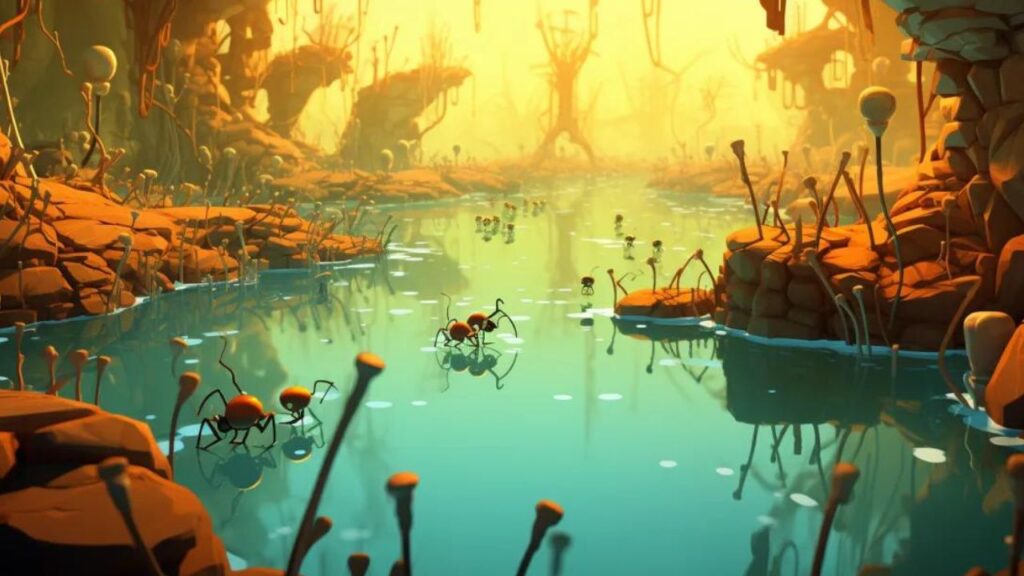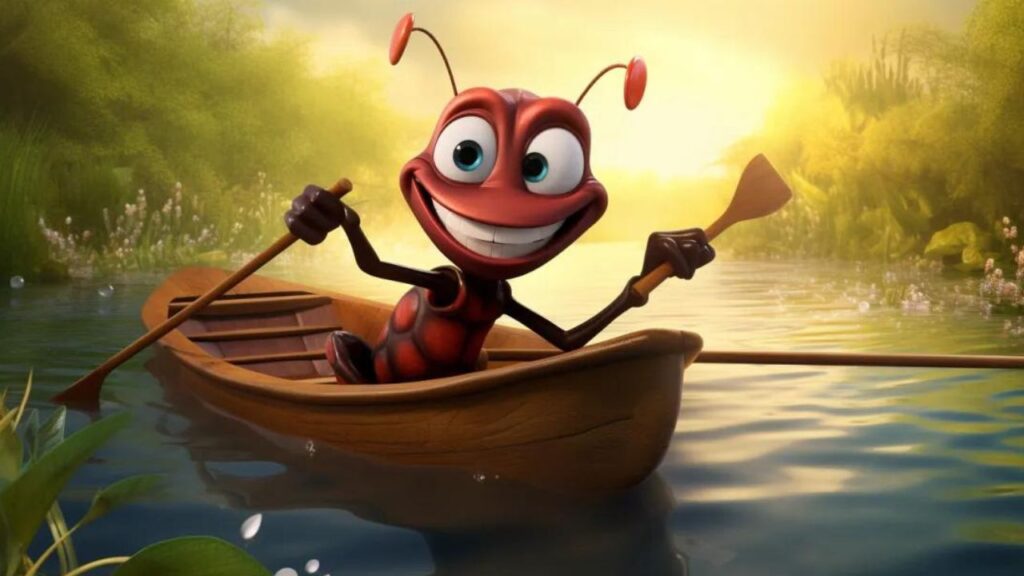Ants and Their Ability to Swim

When one ponders the various skills of ants, swimming may not immediately come to mind. However, through my observations and research in myrmecology, I’ve come to find that ants have a fascinating relationship with water and display behaviors that can be likened to swimming.
The Definition of Swimming
- Swimming or Floating?: Swimming, in the broadest sense, is the ability to move through water by generating motion. For ants, what might appear as swimming is often a combination of floating and paddling, utilizing the surface tension of water to remain buoyant.
- Survival, Not Recreation: For ants, the act of being in water is not for recreation, as it might be in humans, but a necessary survival skill. When submerged, some ants perform movements reminiscent of the dog paddle, but this is not swimming in the traditional sense.
- Utilizing Surface Tension: Ants are small enough that the surface tension of water can keep them afloat. This natural phenomenon allows them to traverse water without sinking, which is often misconstrued as the ability to swim.
Variations Among Ant Species
- Species-Specific Responses: Ant species exhibit different responses to water. For example, the floodplain-dwelling species have more hydrophobic bodies that help them repel water and stay afloat more easily.
- Morphological Differences: The body structure of an ant, including its weight, the density of its exoskeleton, and its limb shape, can affect its ability to deal with water. Some ants have hairier bodies that trap air and aid in flotation.
- Behavioral Adaptations: Ants from wetter climates tend to have more sophisticated water navigation strategies compared to those from arid regions, reflecting their adaptations to their respective habitats.
Observations of Ants in Water
- Struggling or Strategizing?: Observations of ants in water may sometimes be interpreted as struggling. However, these actions are often strategic, such as laying flat to increase surface area or clustering together to form rafts.
- The Fire Ant Phenomenon: One of the most remarkable observations involves fire ants, which can link together to form large, buoyant rafts that can survive for weeks on water. This behavior is a sophisticated survival strategy allowing colonies to endure floods.
- Differences in Dexterity: Not all ants display the same dexterity in water. Some species are adept at creating air bubbles to breathe underwater, while others can only survive for short periods before drowning.
The question of whether ants can swim is complex and cannot be answered with a simple yes or no. While ants do not swim in the conventional sense, they exhibit a wide range of behaviors in response to water. These behaviors vary greatly among species and are a testament to the ants’ adaptability and resilience. Understanding these behaviors not only provides insight into the survival strategies of ants but also enriches our appreciation for the diversity of life and the various ways organisms have adapted to their environments.
How Ants Survive in Water

The ability of ants to survive in water is a fascinating display of nature’s ingenuity. Through my studies of ant behavior, I’ve observed that while ants are not swimmers in the traditional sense, they possess a suite of adaptations and strategies that allow them to survive encounters with water.
Surface Tension and Buoyancy
- Leveraging Physics: Ants can exploit the surface tension of water, a physical property that acts like an invisible film at the water’s surface. Due to their small size and relatively low mass, ants can walk on water without breaking this tension, effectively using it as a barrier between themselves and the liquid below.
- Buoyancy Mechanisms: Their waxy exoskeletons aid in repelling water, enhancing their buoyancy. Some ant species have evolved microscopic hairs on their bodies that trap air, increasing their buoyancy and helping them stay afloat.
- A Balancing Act: When on water, ants distribute their weight evenly and extend their limbs outwards to increase surface area, which helps to maximize their buoyancy and stability.
The Dog Paddle of the Insect World
- Instinctive Movements: If an ant does become submerged, it may perform a kind of dog paddle, an instinctive movement seen in many animals. This action is a survival reflex that can help ants move through water, albeit inefficiently.
- Energy-Intensive Efforts: These paddling movements are energy-intensive and not sustainable for long distances. They are emergency measures, allowing ants to move in water as they seek solid ground.
- Directional Paddling: Ants will often paddle towards light or shadows, which can be indicative of the nearest land. This instinctual behavior demonstrates an ant’s ability to navigate even in challenging conditions.
Creating Rafts and Bridges
- Collective Buoyancy: Some ant species, like fire ants, exhibit remarkable collective behavior when faced with water. They can link their bodies together to form rafts that are highly water-repellent and buoyant.
- Engineering Structures: These living rafts are not haphazard; they are meticulously engineered structures with the ants’ bodies forming interlocking patterns that trap air and increase floatation.
- Bridge Building: Ants are also adept at constructing bridges over water gaps by linking their bodies, allowing the rest of the colony to move across safely. This behavior emphasizes the ants’ collective prioritization of the colony’s survival over the individual.
In essence, ants have developed various strategies to survive in water, capitalizing on surface tension, buoyancy, and their own body mechanics. These methods are largely passive, relying on the ants’ physical properties, but can also involve active behaviors such as paddling or forming complex structures like rafts and bridges. The adaptability of ants to water is a testament to their evolutionary success and highlights the dynamic relationship between organisms and their environments. Through these strategies, ants demonstrate that even in the face of adversity, life finds a way to persevere and adapt.
The Role of Water in Ant Colonies

My investigations into the world of ants have revealed that water plays a multifaceted role in the life of an ant colony. It is both a vital resource and a potential hazard. Here, we’ll delve into the role water plays in the survival strategies, architectural ingenuity, and daily necessities of ant colonies.
Flood Escape Strategies
- Rapid Response: Ant colonies have evolved rapid response mechanisms to deal with the sudden inundation of their habitats. During floods, some species immediately evacuate, carrying larvae and pupae to safety, while others employ the use of water-repellent substances to waterproof their nests.
- Elevation Tactics: Some ants build their nests in elevated areas or even in trees to avoid ground-level flooding. The choice of nest location is a preemptive strategy against the common threat of water inundation.
- Flood-Proofing the Nest: Other species have developed flood-proofing strategies, such as constructing spongy soil structures that float on water or creating intricate drainage systems that channel water away from the nest chambers.
Nest Construction and Moisture Control
- Moisture Regulation: Water is a critical factor in nest construction and maintenance. Ants engineer their nests to regulate moisture levels, ensuring that the internal environment remains at optimal humidity for the health of the colony, particularly for the developing brood.
- Ventilation Systems: Many ant nests feature complex ventilation systems that help control humidity. The architecture of the nest, with its tunnels and chambers, is designed to facilitate air circulation and moisture evaporation.
- Waterproofing Techniques: Some ants use water-repellent materials or their own secretions to line nest walls, which helps prevent the seepage of water into the nest during heavy rains.
Drinking and Water Transportation
- Essential Hydration: Water is essential for ant colonies to drink and to maintain the humidity necessary for brood development. Worker ants collect water and distribute it throughout the colony, ensuring all members remain hydrated.
- Capillary Action and Carrying Drops: Ants utilize capillary action to drink from moist surfaces. They can also carry water droplets back to the nest, held between their mandibles or absorbed into specialized hairs on their bodies.
- Community Effort: Water transportation is a community effort, with ants forming chains or relays to move water from the source to the nest, a process that highlights the colony’s cooperation and social structure.
In the context of ant colonies, water is a crucial element that requires sophisticated management. From constructing flood-resistant nests to intricate moisture control and efficient water distribution systems, ants demonstrate a profound mastery over this essential resource. These strategies not only ensure the colony’s immediate survival but also its long-term health and prosperity. The relationship ants have with water is a dynamic balance of utility and defense, showcasing their remarkable adaptability and collective intelligence.
Ant Species with Notable Swimming Behaviors

As a myrmecologist, I have been particularly captivated by certain ant species that exhibit extraordinary behaviors in relation to water. These behaviors challenge the traditional view of ants as strictly land-bound creatures and demonstrate their incredible adaptability.
The Remarkable Fire Ant Rafts
- Collective Buoyancy: One of the most extraordinary swimming behaviors is exhibited by fire ants (Solenopsis invicta). When faced with flooding, they display an incredible survival strategy by forming living rafts. These rafts can float for days or even weeks, keeping the colony, including the queen and brood, safe until they reach dry land.
- Structural Ingenuity: The ants interlock their bodies, using the buoyancy provided by trapped air bubbles and the water-repellent properties of their exoskeletons. This structure is meticulously organized, maximizing floatation and stability, ensuring the survival of the colony.
- Social Coordination: This behavior is a testament to the fire ants’ social coordination. The formation of a raft is a complex process that requires the cooperation of every individual, demonstrating the colony’s ability to work together under dire circumstances.
Diving Ants: The Exception to the Rule
- Aquatic Adaptations: In the ant world, the genus Camponotus, specifically the species Camponotus schmitzi, is known for its exceptional diving abilities. These ants have adapted to live with the carnivorous plant Nepenthes bicalcarata, diving into the water-filled pitchers to retrieve food.
- Symbiotic Relationship: These ‘diving ants’ have a symbiotic relationship with the pitcher plant. They are capable of swimming and even diving to escape predators or to feed on the small insects trapped within the pitcher’s fluid.
- Air Bubble Reservoir: When diving, these ants trap air bubbles around their spiracles, allowing them to stay submerged for extended periods. This behavior highlights the exceptional adaptations of certain ant species to aquatic environments.
Ants That Use Water for Hunting
- Exploiting Surface Tension: Some ant species use water to their advantage during hunting. For example, the trap-jaw ant (Odontomachus) can use water surfaces to capture prey. They utilize the surface tension of water to pin down prey with their powerful mandibles.
- Hydrodynamic Hunting Techniques: These ants have developed hydrodynamic hunting techniques that allow them to overcome the physical limitations of water. They can move swiftly and strike with precision, turning a potential obstacle into a hunting advantage.
- Adaptive Foraging Strategies: This water-based foraging strategy is an adaptation that allows these ants to exploit a niche that other predators may not be able to access, demonstrating the diversity of ant foraging behaviors and their innovative adaptations to environmental challenges.
The study of ant species with notable swimming behaviors offers a glimpse into the remarkable adaptability of these insects. From the fire ant rafts to the diving behaviors of Camponotus schmitzi and the hydrodynamic hunting strategies of trap-jaw ants, these behaviors underscore the ants’ ability to overcome the challenges posed by water. They exemplify the innovative survival strategies that have allowed ants to thrive in almost every ecosystem on Earth. Each adaptation is a story of survival, ingenuity, and the relentless drive of life to find a way.
Conclusion

As we reflect on the various swimming capabilities and interactions with water observed in ant species, it is clear that these tiny creatures possess an unexpected and profound adaptability. The exploration of ants and their aquatic behaviors has revealed a narrative of resilience and innovation that complements my broader study of myrmecology.
Summarizing Ants’ Swimming Capabilities
- Beyond Simple Swimming: Ants exhibit a range of behaviors in water that extend beyond the simple act of swimming. From leveraging surface tension to stay afloat to forming complex living rafts, ants demonstrate that their interaction with water is as nuanced as it is varied.
- Species-Specific Strategies: Different ant species have evolved distinct strategies to survive and navigate through water. Fire ants are known for their remarkable rafting abilities, while certain diving ants have adapted to submerge themselves completely, and others use the water’s surface to hunt.
- Adaptations for Survival: These behaviors are not just incidental; they are crucial adaptations that have enabled ants to survive environmental challenges such as floods or to exploit new ecological niches.
Ecological Importance of Water Navigation
- Influence on Ant Distribution: The ability to navigate water has significant ecological implications. It influences the distribution and colonization abilities of ant species, allowing them to thrive in diverse and sometimes unexpected habitats.
- Role in Ecosystem Dynamics: Ants’ interactions with water also play a role in ecosystem dynamics. Their rafting and hunting behaviors can affect the populations of other species and contribute to the flow of energy and nutrients within their environments.
- Indicator of Environmental Health: The presence and behaviors of ants in relation to water can serve as indicators of environmental health. Changes in their water navigation patterns may reflect alterations in their ecosystems, providing valuable data for ecological monitoring.
Fascination with Ants’ Adaptability to Water
- A Symbol of Ingenuity: The adaptability of ants to water stands as a symbol of biological ingenuity. It is a testament to the evolutionary creativity that allows life to overcome obstacles and thrive in the face of adversity.
- Insight into Evolutionary Processes: Studying how ants interact with water provides insight into evolutionary processes, showcasing how even small physical and behavioral changes can have a significant impact on survival and success.
- Inspiration for Future Research: The varied aquatic behaviors of ants inspire future research, not only into other aspects of ant biology but also into biomimetic applications where ant-inspired solutions can address human challenges in water navigation and survival strategies.
In wrapping up our examination of ants and their relationship with water, it is evident that these insects are far more than simple land dwellers. Their complex interactions with water showcase a versatility that challenges our understanding of what small creatures are capable of. As I continue to study these fascinating insects, I am constantly reminded of the resilience of life and the endless surprises that studying ants can unveil. Ants, in all their minute glory, are not just surviving; they are thriving by turning one of their biggest threats into one of their most profound assets.






